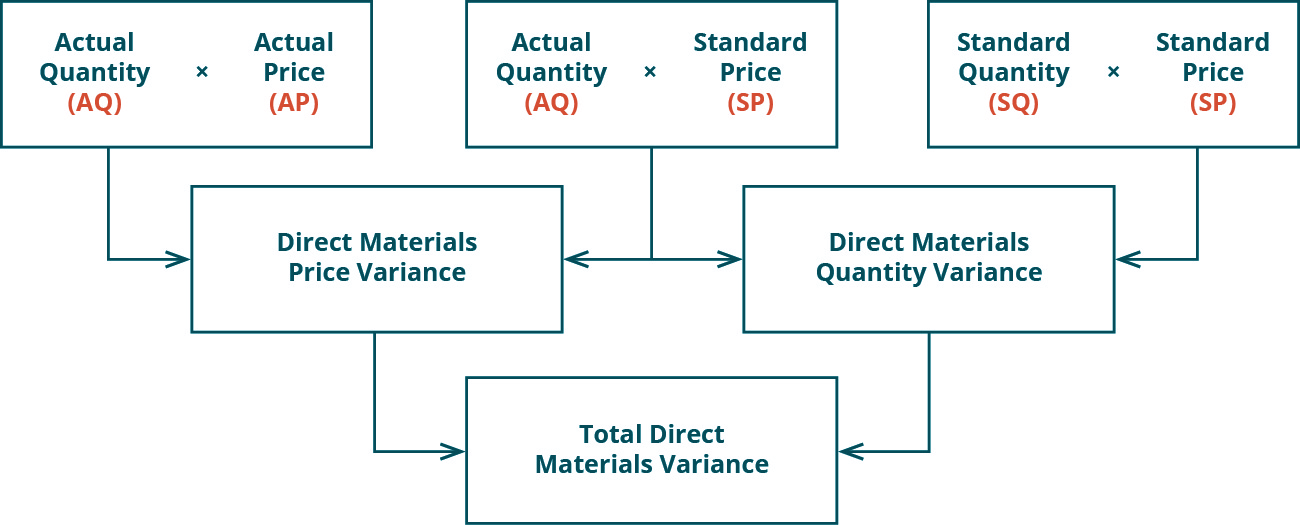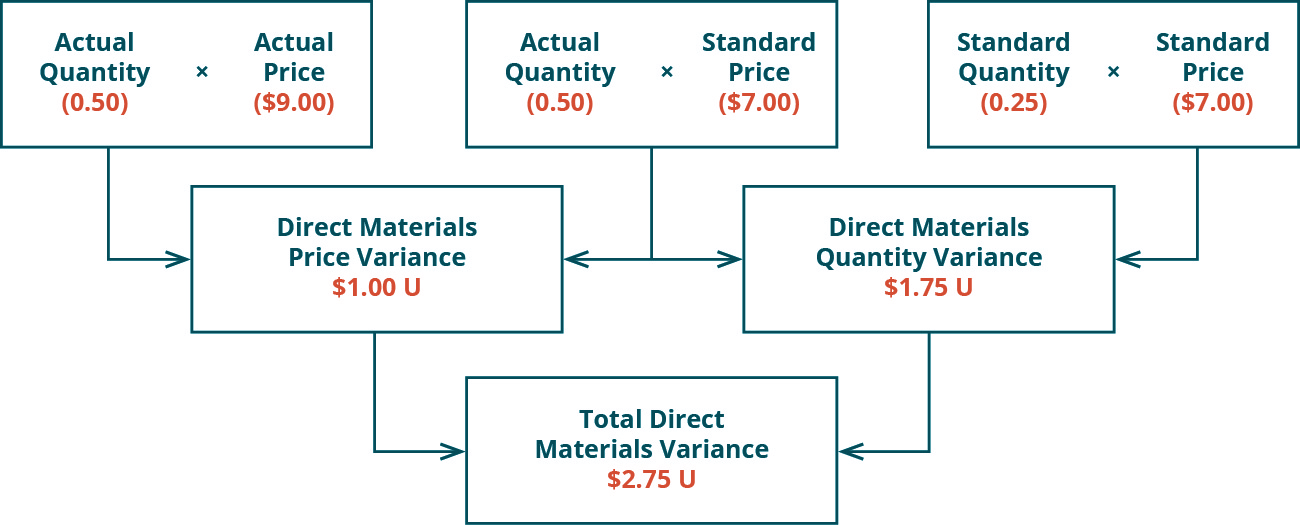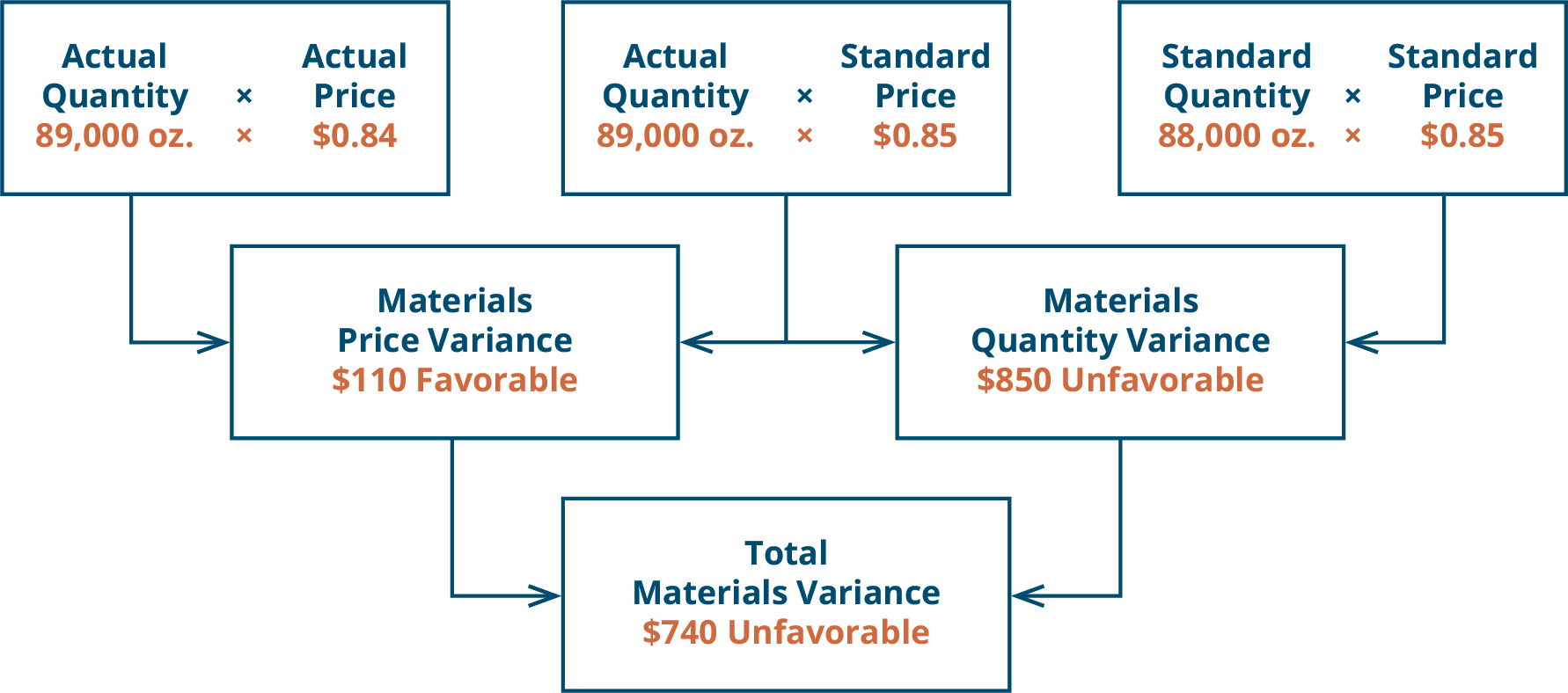10.6 Direct Materials Variances
As you’ve learned, direct materials are those materials used in the production of goods that are easily traceable and are a major component of the product. The amount of materials used and the price paid for those materials may differ from the standard costs determined at the beginning of a period. A company can compute these materials variances and, from these calculations, can interpret the results and decide how to address these differences.
CONCEPTS IN PRACTICE
Buttering Popcorn
In a movie theater, management uses standards to determine if the proper amount of butter is being used on the popcorn. They train the employees to put two tablespoons of butter on each bag of popcorn, so total butter usage is based on the number of bags of popcorn sold. Therefore, if the theater sells 300 bags of popcorn with two tablespoons of butter on each, the total amount of butter that should be used is 600 tablespoons. Management can then compare the predicted use of 600 tablespoons of butter to the actual amount used. If the actual usage of butter was less than 600, customers may not be happy, because they may feel that they did not get enough butter. If more than 600 tablespoons of butter were used, management would investigate to determine why. Some reasons why more butter was used than expected (unfavorable outcome) would be because of inexperienced workers pouring too much, or the standard was set too low, producing unrealistic expectations that do not satisfy customers.
Fundamentals of Direct Materials Variances
The direct materials variances measure how efficient the company is at using materials as well as how effective it is at using materials. There are two components to a direct materials variance, the direct materials price variance and the direct materials quantity variance, which both compare the actual price or amount used to the standard amount.
Direct Materials Price Variance
The direct materials price variance compares the actual price per unit (pound or yard, for example) of the direct materials to the standard price per unit of direct materials. The formula for direct materials price variance is calculated as:

Factoring out actual quantity used from both components of the formula, it can be rewritten as:

With either of these formulas, the actual quantity used refers to the actual amount of materials used to create one unit of product. The standard price is the expected price paid for materials per unit. The actual price paid is the actual amount paid for materials per unit. If there is no difference between the standard price and the actual price paid, the outcome will be zero, and no price variance exists.
If the actual price paid per unit of material is lower than the standard price per unit, the variance will be a favorable variance. A favorable outcome means you spent less on the purchase of materials than you anticipated. If, however, the actual price paid per unit of material is greater than the standard price per unit, the variance will be unfavorable. An unfavorable outcome means you spent more on the purchase of materials than you anticipated.
The actual price can differ from the standard or expected price because of such factors as supply and demand of the material, increased labor costs to the supplier that are passed along to the customer, or improvements in technology that make the material cheaper. The producer must be aware that the difference between what it expects to happen and what actually happens will affect all of the goods produced using these particular materials. Therefore, the sooner management is aware of a problem, the sooner they can fix it. For that reason, the material price variance is computed at the time of purchase and not when the material is used in production.
Let us consider an example. Connie’s Candy Company produces various types of candies that they sell to retailers. Connie’s Candy establishes a standard price for candy-making materials of $7.00 per pound. Each box of candy is expected to use 0.25 pounds of candy-making materials. Connie’s Candy found that the actual price of materials was $6.00 per pound. They still actually use 0.25 pounds of materials to make each box. The direct materials price variance computes as:
In this case, the actual price per unit of materials is $6.00, the standard price per unit of materials is $7.00, and the actual quantity used is 0.25 pounds. This computes as a favorable outcome. This is a favorable outcome because the actual price for materials was less than the standard price. As a result of this favorable outcome information, the company may consider continuing operations as they exist, or could change future budget projections to reflect higher profit margins, among other things.
Let us take the same example except now the actual price for candy-making materials is $9.00 per pound. The direct materials price variance computes as:
In this case, the actual price per unit of materials is $9.00, the standard price per unit of materials is $7.00, and the actual quantity used is 0.25 pounds. This computes as an unfavorable outcome. This is an unfavorable outcome because the actual price for materials was more than the standard price. As a result of this unfavorable outcome information, the company may consider using cheaper materials, changing suppliers, or increasing prices to cover costs.
Another element this company and others must consider is a direct materials quantity variance.
Direct Materials Quantity Variance
The direct materials quantity variance compares the actual quantity of materials used to the standard materials that were expected to be used to make the actual units produced. The variance is calculated using this formula:

Factoring out standard price from both components of the formula, it can be rewritten as:

With either of these formulas, the actual quantity used refers to the actual amount of materials used at the actual production output. The standard price is the expected price paid for materials per unit. The standard quantity is the expected amount of materials used at the actual production output. If there is no difference between the actual quantity used and the standard quantity, the outcome will be zero, and no variance exists.
If the actual quantity of materials used is less than the standard quantity used at the actual production output level, the variance will be a favorable variance. A favorable outcome means you used fewer materials than anticipated, to make the actual number of production units. If, however, the actual quantity of materials used is greater than the standard quantity used at the actual production output level, the variance will be unfavorable. An unfavorable outcome means you used more materials than anticipated to make the actual number of production units.
The actual quantity used can differ from the standard quantity because of improved efficiencies in production, carelessness or inefficiencies in production, or poor estimation when creating the standard usage.
Consider the previous example with Connie’s Candy Company. Connie’s Candy established a standard price for candy-making materials of $7.00 per pound. Each box of candy is expected to use 0.25 pounds of candy-making materials. Connie’s Candy found that the actual quantity of candy-making materials used to produce one box of candy was 0.20 per pound. The direct materials quantity variance computes as:
In this case, the actual quantity of materials used is 0.20 pounds, the standard price per unit of materials is $7.00, and the standard quantity used is 0.25 pounds. This computes as a favorable outcome. This is a favorable outcome because the actual quantity of materials used was less than the standard quantity expected at the actual production output level. As a result of this favorable outcome information, the company may consider continuing operations as they exist, or could change future budget projections to reflect higher profit margins, among other things.
Let us take the same example except now the actual quantity of candy-making materials used to produce one box of candy was 0.50 per pound. The direct materials quantity variance computes as:
In this case, the actual quantity of materials used is 0.50 pounds, the standard price per unit of materials is $7.00, and the standard quantity used is 0.25 pounds. This computes as an unfavorable outcome. This is an unfavorable outcome because the actual quantity of materials used was more than the standard quantity expected at the actual production output level. As a result of this unfavorable outcome information, the company may consider retraining workers to reduce waste or change their production process to decrease materials needs per box.
The combination of the two variances can produce one overall total direct materials cost variance.
Total Direct Materials Cost Variance
When a company makes a product and compares the actual materials cost to the standard materials cost, the result is the total direct materials cost variance.

An unfavorable outcome means the actual costs related to materials were more than the expected (standard) costs. If the outcome is a favorable outcome, this means the actual costs related to materials are less than the expected (standard) costs.
The total direct materials cost variance is also found by combining the direct materials price variance and the direct materials quantity variance. By showing the total materials variance as the sum of the two components, management can better analyze the two variances and enhance decision-making.
Figure 10.35 shows the connection between the direct materials price variance and direct materials quantity variance to total direct materials cost variance.

For example, Connie’s Candy Company expects to pay $7.00 per pound for candy-making materials but actually pays $9.00 per pound. The company expected to use 0.25 pounds of materials per box but actually used 0.50 per box. The total direct materials variance is computed as:
In this case, two elements contribute to the unfavorable outcome. Connie’s Candy paid $2.00 per pound more for materials than expected and used 0.25 pounds more of materials than expected to make one box of candy.
The same calculation is shown using the outcomes of the direct materials price and quantity variances.

As with the interpretations for the materials price and quantity variances, the company would review the individual components contributing to the overall unfavorable outcome for the total direct materials variance, and possibly make changes to production elements as a result.
YOUR TURN
Sweet and Fresh Shampoo Materials
Biglow Company makes a hair shampoo called Sweet and Fresh. Each bottle has a standard material cost of 8 ounces at $0.85 per ounce. During May, Biglow manufactured 11,000 bottles. They bought 89,000 ounces of material at a cost of $74,760. All 89,000 ounces were used to make the 11,000 bottles. Calculate the material price variance and the material quantity variance.
Solution
Actual price per pound: 74,760 ÷ 89,000 = $0.84
Material price variance: 89,000 × (0.84 − 0.85) = $890 favorable
Material quantity variance: 0.85 × (89,000 – 88,000) = $850 unfavorable

Long Description
There are three top row boxes. Two, Actual Quantity (AQ) times Actual Price (AP) and Actual Quantity (AQ) times Standard Price (SP) combine to point to a Second row box: Direct Material Price Variance. Two top row boxes: Actual Quantity (AQ) times Standard Price (SP) and Standard Quantity (SQ) times Standard Price (SP) combine to point to Second row box: Direct Materials Quantity Variance. Notice the middle top row box is used for both of the variances. Second row boxes: Direct Material Price Variance and Direct Materials Quantity Variance combine to point to bottom row box: Total Direct Material Variance. Return
There are three top row boxes. Top row boxes: Actual Quantity (0.50) times Actual Price ($9.00) and Actual Quantity (0.50) times Standard Price ($7.00) combine to point to Second row box: Direct Material Price Variance $1.00 U. Top row boxes: Actual Quantity (.50) times Standard Price ($7.00) and Standard Quantity (0.25) times Standard Price ($7.00) combine to point to Second row box: Direct Materials Quantity Variance $1.75 U. Notice the middle top row box was used for both variances. The two second row boxes: Direct Material Price Variance $1.00 U and Direct Materials Quantity Variance $1.75 U combine to point to the one bottom row box: Total Direct Material Variance $2.75 U. Return
There are three top row boxes. Top row boxes: Actual Quantity (89,000 ounces) times Actual Price ($0.84) and Actual Quantity (89,000 ounces) times Standard Price ($0.85) combine to point to Second row box: Direct Material Price Variance $890 Favorable. Top row boxes: Actual Quantity (89,000 ounces) times Standard Price ($0.85) and Standard Quantity (88,000 ounces) times Standard Price ($0.85) combine to point to Second row box: Direct Materials Quantity Variance $850 Unfavorable. Notice the middle top row box was used for both variances. The two second row boxes: Direct Material Price Variance $890 Favorable and Direct Materials Quantity Variance $850 Unfavorable combine to point to the one bottom row box: Total Direct Material Variance $40 Favorable. Return

